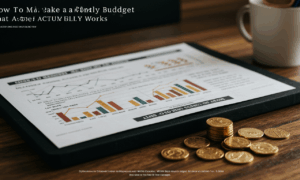The Power of Compound Interest: How to Make Your Money Grow
Have you ever wondered how some people build significant wealth over time, seemingly without winning the lottery or inheriting a fortune? The answer often lies in a powerful, yet surprisingly simple financial concept: compound interest. Albert Einstein reportedly called it the eighth wonder of the world, and for good reason. Understanding and harnessing its power is one of the most effective strategies you can use to make your money grow and achieve your long-term financial goals. This article will demystify compound interest and provide you with actionable steps to put this incredible force to work for you.
Far from being an exclusive tool for the ultra-rich, compound interest is accessible to anyone willing to start saving and investing, no matter how small the initial amount. It’s the engine behind successful retirement plans, education funds, and the journey toward financial independence. We will explore what it is, how it works, and the practical ways you can leverage it to build a more secure financial future.
What Exactly Is Compound Interest? The Snowball Effect on Your Finances
To grasp the magic of compounding, you first need to understand its simpler counterpart: simple interest. Simple interest is calculated only on the initial amount of money you invest, known as the principal. If you invest $1,000 at a 5% simple annual interest rate, you will earn $50 every year. After 20 years, you would have earned $1,000 in interest ($50 x 20 years), for a total of $2,000.
Compound interest, on the other hand, is far more dynamic. It is interest on interest. In the first year, the calculation is the same as simple interest. But in the second year, you earn interest on both your initial principal and the interest you accumulated in the first year. This creates a snowball effect that grows larger and faster over time.
Let’s use that same $1,000 at a 5% annual interest rate, but this time, it’s compounded annually:
- Year 1: You earn 5% of $1,000, which is $50. Your new total is $1,050.
- Year 2: You earn 5% of $1,050, which is $52.50. Your new total is $1,102.50.
- Year 3: You earn 5% of $1,102.50, which is $55.13. Your new total is $1,157.63.
While the difference seems small at first, over 20 years, that same $1,000 would grow to approximately $2,653. That’s over $650 more than with simple interest, all without you lifting a finger after the initial investment. This accelerating growth is the core of wealth accumulation.

The Three Essential Pillars of Compounding
The effectiveness of compound interest hinges on three critical variables. Understanding how they interact is key to maximizing your financial growth. If you want to build a solid foundation, focus on optimizing these three elements within your personal savings strategy.
1. Principal: Your Initial Capital
The principal is the amount of money you start with. A larger initial investment will naturally generate more interest and give your compounding journey a head start. However, do not be discouraged if you can only start with a small amount. The most important step is simply to start. Regular contributions, which add to your principal over time, are just as powerful, if not more so, than a large one-time investment.
2. Rate of Return: The Engine of Your Growth
The interest rate, or rate of return, is the percentage at which your money grows each period. A higher rate of return will accelerate the compounding process significantly. For instance, an investment growing at 8% per year will become much larger than one growing at 4% over the same period. This is why exploring different investment vehicles beyond a standard savings account is crucial for long-term growth. Different financial products offer varying rates of return, often tied to their level of risk.
3. Time: The Most Powerful Ingredient
Of all the factors, time is the most critical and forgiving. The longer your money has to work for you, the more dramatic the effects of compounding will be. The growth is not linear; it’s exponential. This means the biggest gains often happen in the later years of an investment.
Consider two individuals:
- Early Starter: Starts investing $200 per month at age 25 and stops at age 35 (10 years of contributions, totaling $24,000). They then let the money grow without adding more until age 65.
- Late Starter: Starts investing the same $200 per month at age 35 and continues until age 65 (30 years of contributions, totaling $72,000).
Assuming a 7% average annual return, the Early Starter, despite investing far less money, will end up with a larger nest egg than the Late Starter. This is the undeniable power of giving your money more time to compound. The lesson is clear: the best time to start investing was yesterday. The second-best time is today.
How to Put Compound Interest to Work for You
Knowing the theory is one thing; applying it is another. Here are practical ways to harness the power of compound interest in your financial life.
Start with Accessible Financial Products: You do not need to be an expert to begin. High-yield savings accounts and Certificates of Deposit (CDs) are low-risk options that offer better returns than traditional savings accounts, allowing you to experience compounding safely. Explore our section on financial products to learn more about your options.
Invest for the Long Term: To achieve higher rates of return, consider investing in the stock market through diversified vehicles like Exchange-Traded Funds (ETFs) or mutual funds. These instruments spread your investment across many companies, which helps manage risk while capturing the market’s potential for growth. Over long periods, the stock market has historically provided returns that significantly outpace inflation and standard savings rates.
Leverage Retirement Accounts: Accounts like a 401(k) or an Individual Retirement Account (IRA) are specifically designed to maximize long-term growth. They offer significant tax advantages, such as tax-deferred or tax-free growth, which means your money can compound without being eroded by annual taxes. If your employer offers a 401(k) match, contribute at least enough to get the full match—it’s essentially free money that turbocharges your principal.
Automate and Be Consistent: The single best habit for successful long-term investing is consistency. Set up automatic transfers from your checking account to your investment accounts each month. This “pay yourself first” strategy ensures you are continuously adding to your principal, regardless of market fluctuations. It removes emotion from the equation and builds a powerful, disciplined habit.
Conclusion: Your Path to Financial Growth
Compound interest is not a get-rich-quick scheme; it is a get-rich-surely strategy. It is a testament to the power of patience, discipline, and long-term thinking. By understanding its core principles—starting with a principal, securing a reasonable rate of return, and giving your investment ample time to grow—you can transform small, consistent savings into substantial wealth.
The journey to financial security begins with a single step. Whether you are opening your first investment account or increasing your monthly contributions, every action you take today puts the incredible force of compounding on your side. Take control of your financial future, make your money work for you, and watch it grow into something truly remarkable.
Frequently Asked Questions (FAQ)
Is compound interest only for people who can invest large amounts of money?
Absolutely not. Compound interest works on any amount of money, big or small. The key is not the size of your initial investment but the discipline of starting early and contributing regularly. Even small, consistent contributions can grow into a significant sum over several decades thanks to the power of time and compounding.
What is the biggest mistake to avoid with compound interest?
The single biggest mistake is procrastination. Delaying the start of your investment journey is incredibly costly because time is the most powerful component of the compounding formula. Every year you wait is a year of potential growth you can never get back. Another significant mistake is interrupting the process by making early withdrawals, which resets the compounding clock and can drastically reduce your final outcome.
How do I know which investments use compound interest?
Most modern investment and savings vehicles are designed to use compound interest. This includes high-yield savings accounts, retirement accounts (like 401(k)s and IRAs), stocks, bonds, mutual funds, and ETFs. The key feature to look for is the “reinvestment of earnings.” For example, with stocks, reinvesting dividends allows you to buy more shares, which then generate their own dividends, perfectly illustrating the compounding process.





